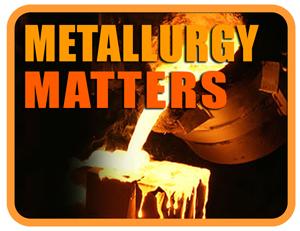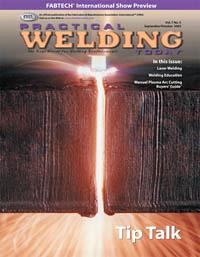Contributing Writer
- FMA
- The Fabricator
- FABTECH
- Canadian Metalworking
Categories
- Additive Manufacturing
- Aluminum Welding
- Arc Welding
- Assembly and Joining
- Automation and Robotics
- Bending and Forming
- Consumables
- Cutting and Weld Prep
- Electric Vehicles
- En Español
- Finishing
- Hydroforming
- Laser Cutting
- Laser Welding
- Machining
- Manufacturing Software
- Materials Handling
- Metals/Materials
- Oxyfuel Cutting
- Plasma Cutting
- Power Tools
- Punching and Other Holemaking
- Roll Forming
- Safety
- Sawing
- Shearing
- Shop Management
- Testing and Measuring
- Tube and Pipe Fabrication
- Tube and Pipe Production
- Waterjet Cutting
Industry Directory
Webcasts
Podcasts
FAB 40
Advertise
Subscribe
Account Login
Search
Metallurgy Matters: Making steels stronger
- By Bob Capudean
- October 9, 2003
- Article
- Metals/Materials
As we get into modifying a steel's strength and hardness, keep a couple things in mind. First, don't confuse hardness with hardenability. A steel's maximum hardness is a function of its carbon content: more carbon, more hardness. Hardenability, on the other hand, refers to the amount of martensite that forms in the microstructure during cooling.
Second, low-hardenability steels require rapid cooling to transform martensite, while high-hardenability steels form martensite when they're air-cooled. These hardenability characteristics are important because they help identify how much a steel will harden during welding.
Tempering Martensite
Martensite in the "as quenched" condition is usually extremely brittle and, therefore, not much good to anyone. But a tempering heat treatment can increase ductility and toughness effectively with only slight to moderate reduction in strength.
Generally speaking, tempering involves reheating hardened steel to a specific temperature and holding it there for a short time before cooling. This increases toughness (resistance to shock or impact loading) and reduces brittleness by allowing carbon to precipitate into tiny carbide particles. The microstructure that results is called tempered martensite.
The relationship between the resulting hardness and toughness is actually a compromise that's controlled by using a specific tempering time and temperature. The higher the temperature is, the softer and tougher the steel is. I'll get into more detail on this later in this article. Quenching and tempering improve the qualities of structural steels, pressure vessels, and even machinery. When low-alloy steels are quenched and tempered, the result is high tensile and yield strength and improved notch toughness, especially when compared to hot-rolled, normalized, or annealed steel.
Strengthening Metals
There are four ways to increase a metal's strength:
- Cold working
- Solid-solution hardening
- Transformation hardening
- Precipitation hardening
While precipitation hardening is an effective way to develop high strength and hardness in some steels, it's most often an aluminum-alloy application and is a little more complicated than the others, so I'll cover it in an upcoming column.
Cold working a metal deforms and stresses its crystal structures, causing the metal to work-harden. Steel mills cold-work steel by running it back and forth through rollers with the steel at a temperature below the plastic state. This distorts the steel's grain structure, which increases its hardness and tensile strength while decreasing ductility. Sheet metal fabricators and hammer formers deal with this too. After a piece of tempered sheet metal or aluminum is worked with a hammer for a while, it begins to get hard and brittle, so you may need to temper it again to be able to keep working it without cracking or splitting it.
Solid solution hardening stresses a metal's crystal structure by adding alloying metals that don't fit easily in the base metal's crystal lattice. This added stress increases tensile strength and decreases ductility.
Transformation hardening is the heat-quench-tempering heat treatment cycle addressed earlier in this article. It's used to adjust strength and ductility to meet specific application requirements. There are three steps to transformation hardening:
- Cause the steel to become completely austenitic by heating it 50 to 100 degrees F above its A3-Acmtransformation temperature (from that steel's iron-carbon diagram). This is called austenitizing.
- Quench the steel; that is, cool it so fast that the equilibrium materials of pearlite and ferrite (or pearlite and cementite) can't form, and the only thing left is the transitional structure martensite. The idea here is to form 100 percent martensite.
- Reduce brittleness by tempering the martensitic steel, which requires heating it, but keep temperatures below A1. Typically, this means temperatures are between 400 and 1,300 degrees F, which allows some of the martensite to turn into pearlite and cementite. Then allow the piece to air-cool slowly.
By using the proper heat treatment and choosing a steel with just the right amount of carbon, you can get just about any combination of hardness and ductility to meet a specific requirement. Remember, the more pearlite and cementite that forms, the more ductile and less brittle the steel will be. Conversely, more martensite means less ductility but more hardness.
One topic I've ignored up to this point is grain structure changes during precipitation hardening. A steel's grain size depends on the austenitizing temperature. When a steel that will transform is heated to slightly above its A3temperature and then cooled to room temperature, grain refinement takes place. Fine grain size offers better toughness and ductility.
Austenitizing temperatures higher than 1,800 degrees F generally cause a coarse austenitic grain structure, and these coarse-grained steels are usually inferior to fine-grained steels in terms of strength, ductility, and toughness. Steel forgings and castings are often normalized specifically to refine their grain structure.
How Welding Affects Hardening
It should be apparent that it sometimes requires a lot to strengthen a metal correctly. So, just how much do you affect all that work when you weld two pieces of hardened steel together? It depends.
First, recognize that it's not just the welded joint but the entire heat-affected zone (HAZ) that's subject to influences from welding heat. Defined as the portion of the base metal whose mechanical properties or microstructure have been altered by the heat of welding, brazing, soldering, or thermal cutting, the HAZ can sometimes be quite large.
Second, it depends on what form of strengthening was used. For example, work-hardened metals recrystallize and soften substantially in the HAZ. Solid solution-hardened metals will have a little grain growth next to the fusion line, but it's usually only a few grains wide and has little effect on the metal's properties.
Transformation-hardened alloys with enough hardenability to form martensite or have formed martensite during previous heat treatment react much like a solid solution-hardened metal: There's little change in the HAZ compared to other hardening techniques, aside from minor grain growth at the fusion line. Precipitation-hardened metals go through some complex changes, but the result is similar to work-hardened metals: Base metal in the HAZ goes through an annealing cycle and softens.
That covers the basics of metal strengthening techniques and how those techniques influence a metal's microstructure. Next time we'll take a closer look at how welding affects hardened metals and what you can do to reduce those effects, and then we'll get into welding metallurgy.
About the Author

Bob Capudean
Back Alley Customs
About the Publication
subscribe now

The Welder, formerly known as Practical Welding Today, is a showcase of the real people who make the products we use and work with every day. This magazine has served the welding community in North America well for more than 20 years.
start your free subscription- Stay connected from anywhere

Easily access valuable industry resources now with full access to the digital edition of The Fabricator.

Easily access valuable industry resources now with full access to the digital edition of The Welder.

Easily access valuable industry resources now with full access to the digital edition of The Tube and Pipe Journal.
- Podcasting
- Podcast:
- The Fabricator Podcast
- Published:
- 04/16/2024
- Running Time:
- 63:29
In this episode of The Fabricator Podcast, Caleb Chamberlain, co-founder and CEO of OSH Cut, discusses his company’s...
- Industry Events
16th Annual Safety Conference
- April 30 - May 1, 2024
- Elgin,
Pipe and Tube Conference
- May 21 - 22, 2024
- Omaha, NE
World-Class Roll Forming Workshop
- June 5 - 6, 2024
- Louisville, KY
Advanced Laser Application Workshop
- June 25 - 27, 2024
- Novi, MI
































